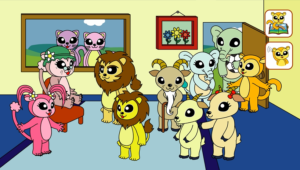 Hi, Everyone and welcome to the Happy Valley Blog. We are very excited to bring this blog to you. Here we will write about teaching tips, our personal reflections as teachers using Happy Valley and announcements about events and offers that pop up in the future.
Hi, Everyone and welcome to the Happy Valley Blog. We are very excited to bring this blog to you. Here we will write about teaching tips, our personal reflections as teachers using Happy Valley and announcements about events and offers that pop up in the future.
I’m Catherine Oki, co-author of Happy Valley. Recently, we have been at the ETJ Expos in Tokyo and Kansai. Next weekend, Chiyuki Yanase will go to Nagoya. Then, on 12/2, I will be in Sendai and finally on 12/9 I will go to Fukuoka.
Chiyuki Yanase had a wonderful presentation in Tokyo on Saturday, November 3rd. I presented on the 4th, also in Tokyo, and for my first presentation on Happy Valley, I have to admit that I was nervous. In fact, I even made a mistake during the first activity. Everyone said they couldn’t tell, but I knew I had made a mistake. Despite that, I had to just keep going.
After the presentation, it made me think about two things. First, sometime this happens in class, doesn’t it? You think of a new activity or try something new, but maybe it doesn’t go well. So, you have to think quickly and change it. As teachers, we know this sometimes happens. We do our best in the moment and then we figure out after how we can make it better. For me, I was lucky to be able to do the presentation again last weekend in Kansai. The second time, each activity went according to plan. I learned from my mistake and fortunately I could make it right the next opportunity. Second, this made me think about the mistakes our students make in class and how valuable that process is. I think I learn more from my mistakes than my successes. Mistakes challenge me to think. I believe it is the same for our students. When they make a mistake, shouldn’t we give them a chance to correct it, like we get to? I think so.
Thinking and doing are different, though, so how can we do it without disrupting the class flow or making the student feel bad? Let me give an example of two things I have tried that work. If a student answers, “Yellow,” when I show a flashcard with the color red on it, I might give a doubtful look and sing the song to try and jiggle the student’s memory. This gives the student more time to think of the right answer. By doing this, I can also have the other students who are waiting join in singing with me. If this doesn’t work, I will say to the other students, “Is it yellow? Can someone tell Taro what color it is?” Then a student who knows can whisper it to Taro and he can try again. I ask Taro to thank the student who helped him, too. Everyone gets feedback and chances are Taro will remember what red is, having had a chance to find the answer another way.
In this way, I think our students are not so different from us teachers. We all make mistakes and need chances to fix them. Do you give students the time and chance to fix their mistakes? If so, how do you do that? I’d love to learn some new ways from you!